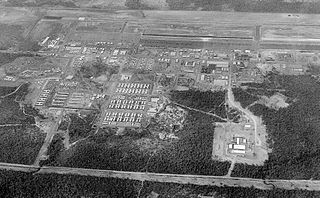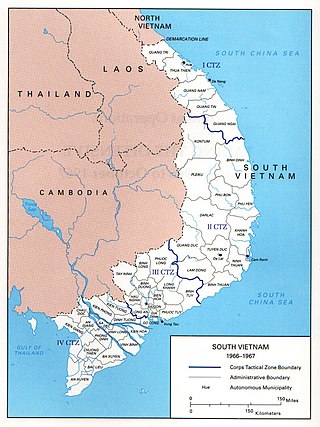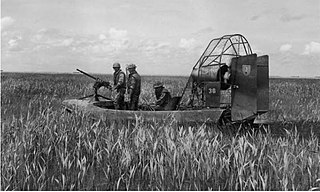Related Research Articles

The Vietnam War was a conflict in Vietnam, Laos, and Cambodia from 1 November 1955 to the fall of Saigon on 30 April 1975. It was the second of the Indochina Wars and a major conflict of the Cold War. While the war was officially fought between North Vietnam and South Vietnam, the north was supported by the Soviet Union, China, and other countries in the Eastern Bloc, while the south was supported by the US and anti-communist allies. This made it a proxy war between the US and Soviet Union. It lasted almost 20 years, with direct US military involvement ending in 1973. The conflict spilled into the Laotian and Cambodian civil wars, which ended with all three countries becoming communist in 1975.

Air America was an American passenger and cargo airline established in 1946 and covertly owned and operated by the Central Intelligence Agency (CIA) from 1950 to 1976. It supplied and supported covert operations in Southeast Asia during the Vietnam War, including providing support for drug smuggling in Laos.
The Royal Lao Air Force, best known to the Americans by its English acronym RLAF, was the air force component of the Royal Lao Armed Forces (FAR), the official military of the Royal Lao Government and the Kingdom of Laos during the Laotian Civil War between 1960 and 1975.
This is a list of aviation-related events from 1964.

Tan Son Nhut Air Base (1955–1975) was a Republic of Vietnam Air Force (RVNAF) facility. It was located near the city of Saigon in southern Vietnam. The United States used it as a major base during the Vietnam War (1959–1975), stationing Army, Air Force, Navy, and Marine units there. Following the Fall of Saigon, it was taken over as a Vietnam People's Air Force (VPAF) facility and remains in use today.

The Nakhon Phanom Royal Thai Navy Base (NKP), formerly Nakhon Phanom Royal Thai Air Force Base, is a Royal Thai Navy facility used for riverine patrols along the Mekong River. It is approximately 587 km (365 mi) northeast of Bangkok, 14.5 km (9.0 mi) west of Nakhon Phanom city in Nakhon Phanom Province in the northeastern region of Thailand, and 411 km (255 mi) from Hanoi in Vietnam. The Mekong River is NKP's border with Laos. The airfield at NKP is jointly used as a civilian airport.

The attack on Camp Holloway occurred during the early hours of February 7, 1965, in the early stages of the Vietnam War. Camp Holloway was a helicopter facility constructed by the United States Army near Pleiku in 1962. It was built to support the operations of Free World Military Forces in the Central Highlands of South Vietnam.

Operation Pony Express was the covert transportation of, and the provision of aerial support for, indigenous soldiers and material operating across the Laotian and North Vietnamese borders during the Vietnam War. It was provided by Sikorsky CH-3C helicopters of the US 20th Helicopter Squadron, the only USAF combat helicopter squadron in Vietnam, which had been transferred there in 1965 and was known as the "Pony Express".
Project DELTA was the first of the Reconnaissance Projects, which were special reconnaissance (SR) units named with a Greek letter. The Reconnaissance Projects were formed by the U.S. Military Assistance Command, Vietnam (MACV) during the Vietnam War to collect operational intelligence in remote areas of South Vietnam.

The Viet Cong (VC) insurgency expanded in South Vietnam in 1962. U.S. military personnel flew combat missions and accompanied South Vietnamese soldiers in ground operations to find and defeat the insurgents. Secrecy was the official U.S. policy concerning the extent of U.S. military involvement in South Vietnam. The commander of Military Assistance Command, Vietnam (MACV), General Paul D. Harkins, projected optimism that progress was being made in the war, but that optimism was refuted by the concerns expressed by a large number of more junior officers and civilians. Several prominent magazines, newspapers and politicians in the U.S. questioned the military strategy the U.S. was pursuing in support of the South Vietnamese government of President Ngô Đình Diệm. Diệm created the Strategic Hamlet Program as his top priority to defeat the VC. The program intended to cluster South Vietnam's rural dwellers into defended villages where they would be provided with government social services.

Dak Pek Camp is a former U.S. Army and Army of the Republic of Vietnam (ARVN) base northwest of Kon Tum in the Central Highlands of Vietnam.
Katum Camp is a former U.S. Army and Army of the Republic of Vietnam (ARVN) base northeast of Tây Ninh in southern Vietnam.

The Hurricane Aircat was an airboat used as a riverine patrol boat by the US Army and South Vietnamese Army (ARVN) during the Vietnam War. It was used to conduct various counterinsurgency (COIN) and patrol missions in riverine and marshy areas where larger boats could not go.

The Vietnam War involved many countries across the world. North Vietnam received support from the Eastern Bloc, while South Vietnam was generally supported by nations of the Western Bloc.
References
- 1 2 "Vietnam Archive Operations Database". The Vietnam Center and Archive.
- ↑ "Operation report information". Vietnam Helicopter Pilots Association.
- ↑ "Operation report information". Vietnam Helicopter Pilots Association.
- ↑ Whitlow, CAPT Robert (1977). U.S. Marines in Vietnam: the Advisory & Combat Assistance Era, 1954-1964. U.S. Government Printing Office. p. 149. ASIN B00313IWUI.
- ↑ Whitlow, p. 152-154
- 1 2 3 4 5 6 7 8 9 10 11 12 13 14 15 16 17 18 19 20 21 22 "Special Report to the Co-Chairmen of the Geneva Conference on Indo-China" (PDF). International Commission for Supervision and Control in Vietnam. 13 February 1965. pp. 19–20. Archived from the original (PDF) on 5 February 2007. Retrieved 28 July 2010.
- ↑ Stanton, Shelby (1999). Green Berets at War: U.S. Army Special Forces in Southeast Asia, 1956-1975. Ballantine Books. p. 218. ISBN 978-0-8041-1884-2.
- ↑ Frankum, Ronald (2005). Like Rolling Thunder: The Air War in Vietnam 1964-1975. Rowman & Littlefield. ISBN 978-0-7425-4302-7.
- ↑ "Operation report information". Vietnam Helicopter Pilots Association.
- ↑ "Operation report information". Vietnam Helicopter Pilots Association.
- ↑ Stanton, p. 218
- ↑ "MACV Command History Chronology 1964". Archived from the original on 2011-08-14. Retrieved 2010-07-28.
- ↑ "Operation report information". Vietnam Helicopter Pilots Association.
- ↑ Warner, Roger (1996). Shooting at the Moon: The Story of America's Clandestine War in Laos. Steerforth Press. p. 135. ISBN 978-1-883642-36-5.
- ↑ Morocco, John (1985). The Vietnam Experience Rain of Fire: Air War, 1969–1973 . Time-Life Books. p. 26. ISBN 978-0-939526-14-7.
- ↑ "Operation report information". Vietnam Helicopter Pilots Association.